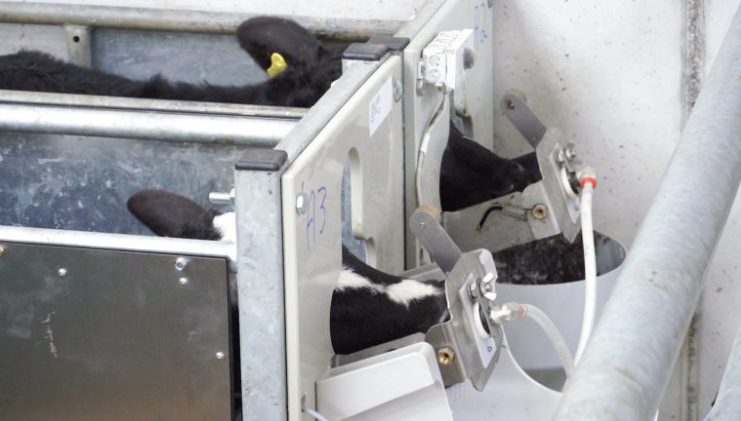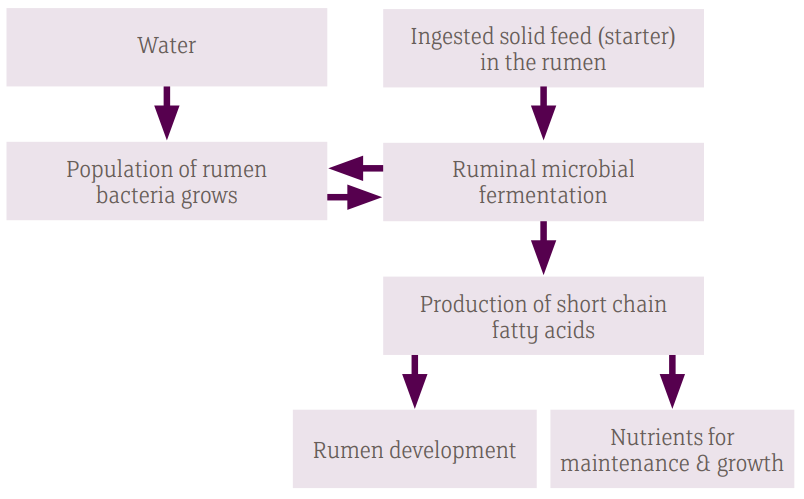In part 2 of the ‘Calf Health Series’, we will examine the area of nutrition and look at what options are available when it comes to feeding the calf, after an adequate intake of colostrum has been achieved.
From newborn calf to high-yielding cow, it starts with milk and ends with milk. The aim of all dairy farmers should be the successful rearing of replacement heifers to enter the herd at the correct weight and age for optimum milk production and fertility performance.
Young stock management is not an easy job; it requires a high level of skill, time and patience.
By focusing on calf rearing, and achieving a better understanding of calf nutrition and development, farmers will reap the benefits in the long term.
Enhanced early nutrition optimises the rapid early growth potential of young calves. Although feed remains the main cost associated with calf rearing, younger calves have higher feed conversion efficiency (FCE) than older cattle.
Therefore, this must be optimised at an early age in order to capitalise on the rapid early growth capability of pre-weaned calves.
- Rapid growth of frame size – skeletal and muscle;
- Improved heaIth status;
- Decreased time to first calving;
- Optimised reproduction and milk production as a cow.
All farmers must set achievable targets for their calf-rearing enterprise. These targets include: a doubling in weight from birth to weaning (40kg to 80kg by eight weeks-of-age); a calf mortality rate of <3% at three weeks-of-age; and calf treatments at <10%.
 If farmers can achieve these targets, they can optimise the most efficient period of the calf’s life, reduce age at first calving (by breeding heifers younger) and increase milk yield, herd longevity and produce healthier animals.
If farmers can achieve these targets, they can optimise the most efficient period of the calf’s life, reduce age at first calving (by breeding heifers younger) and increase milk yield, herd longevity and produce healthier animals.
Whole milk vs. milk replacer?
Using milk replacer to feed calves offers many benefits over whole milk. It helps reduce the risks of scour, Johne’s Disease and problems with feeding antibiotic milk.
It is consistent, made only from pasteurised milk and outperforms whole milk time and time again. What’s more, milk replacer is actually a cheaper option than feeding saleable whole milk.
While whole milk can provide a high level of energy and proteins, it can also also transmit bacteria which will infect the calf, such as: Johne’s Disease; Salmonella; and E.Coli.
Also, the variation in nature of whole milk can lead to calf performance and health issues. On top of this, feeding whole milk can result in delayed intake of solid feed, which can delay the age of a successful weaning period or result in post-weaning growth checks.
- Biosecurity – made using pasteurised milk;
- Convenient and easy to use and always available;
- Lower fat; higher lactose – encouraging solid feed intake before and after weaning;
- Formulated to provide a consistent supply of energy, protein, vitamins and trace elements.
Feeding milk replacer
When feeding a replacer, it’s important to give serious consideration to the product that lies within the bag. The days of picking up the first bag you see in your local merchant should be well and truly over.
Remember, this is the next generation of cows you are feeding and getting them off to the best possible start will have benefits when it comes to hitting target weights and, in turn, when you’re cupping them in the parlour down the line.
Or, these are bull calves that will be purchased by a beef farmer. Again, getting these calves off to the best start will allow these animals to reach future growth targets and result in a more saleable calf.
- Minimum of 20% protein declared;
- Maximum of 8% ash declared – a target for ash content should be 6.5-7.5%;
- Minimum of 0.8% calcium;
- A trusted supplier;
- Previous calf performance and calf bloom give the best guarantee for milk replacer quality.
In the early stages of life, quality – not just quantity – is vital. Farmers need to choose a milk replacer with a consistent formulation of quality ingredients – then find a product to match their system.
For example, farmers should offer high-performance heifers more of a higher protein, lower oil formulation; beef-cross calves can be fed a lower level of a more economic replacer.
Twice-a-day (TAD) feeding provides twice as much opportunity to observe calf behaviour and identify any signs of disease at the earliest possible stage.
Computerised feeders offer the benefits of labour saving, whilst allowing farmers to manage their calves more effectively.
Individual calf recognition and feeding on a ‘little and often’ basis promotes good calf performance, coupled with early warning systems to highlight any potential health problems.
Most stock people know that feeding milk replacer at body temperature, around 38°C, is very important. The reasons for this relate to effective closure of the oesophageal groove which directs liquid feed straight into the abomasum.
How much to feed?
Instructions for feeding milk replacer to calves are generally provided on the bag; for example to make up 1L of milk replacer, mix 125g of powder and 875ml of water.
This is why it is essential to know exactly how much milk replacer is being measured in jugs or scoops to ensure calf target goals are met.
Depending on farm targets and the growth you are trying to achieve, milk replacer can be fed at varying concentrations from 10% to 20%.
Feeding at 10% solids — about 500g of milk powder / day will provide enough nutrients for maintenance, but will restrict growth rates. Calves require energy and protein to support and maintain their normal body functions (maintenance), and for growth and immune function.
To achieve a minimum growth of 0.8kg/day pre-weaning, 700-900g of milk solids per calf/day should be fed in at least two feeds. In accordance with legislation from the EU, once-a-day (OAD) feeding should be employed as a management tool for calves over 28 days-of-age.
Good-quality milk replacer should contain 20-26% protein and 16-20% oil. Milk replacer such as Volac’s Heiferlac – with its high level of quality protein (26%) and low oil level (16%) – will help promote lean tissue growth and limit body fat deposition.
Examples of different mixing and feeding options to provide the calf with the desired amount of milk solids per day are provided in the table below.
When environmental temperature falls, calf growth rates plummet, simply because they require so much more energy just to keep warm and there is, therefore, less available energy for growth.
Less energy is also available for immune function meaning that calves are more susceptible to respiratory infections and scours.
During periods of extreme cold weather, it is vital to feed calves enough milk to provide them with the required extra energy – especially if they are housed in hutches. The higher nutrient supply will help maintain body temperature, preserve growth rates and make calves less susceptible to disease.
How much extra to feed during cold weather?
For a young calf (0-3 weeks-of-age) weighing 50kg, feed an extra 100g of milk powder / day for each 10°C drop in ambient temperature below 20°C, for them to continue to grow at the same rate as when it’s warm outside.
For example, if the outside temperature is 0°C, feed calves an extra 200g/day; this can be achieved by either increasing the mixing rate or by increasing the volume fed.
For a calf older than three weeks-of-age, feed an extra 100g milk of powder / day for each 10ºC drop in ambient temperature below 10°C. For example, if the outside temperature is 0°C, feed calves an extra 100g/day.
Additionally, farmers can help their calves to cope with periods of very cold weather, avoid stress and maintain daily liveweight gain if they take up the following points.
- Make sure every calf receives adequate colostrum;
- Accurately measure volumes of milk replacer and water;
- Increase levels of milk replacer fed gradually – to provide the extra energy and nutrients needed;
- Provide calves with a fresh clean supply of water, concentrates and straw in racks;
- Reduce cold air draughts whilst maintaining adequate ventilation, for example, by using whole bales in the shed – cold air draughts increase body heat loss;
- Use deep straw bedding – it provides a great deal of insulation and reduces body heat loss;
- Keep bedding dry and clean – much of the insulation value of bedding is lost when it is wet.
Skim vs. Whey
Whey and skim-based milk replacers can have similar protein and fat levels. But good nutrition and calf performance is linked to more than just protein and fat levels in the milk replacer.
Important differences in amino acid and fatty acid profiles, the amount of lactose, important vitamins, minerals and trace elements, processing conditions and overall digestibility all contribute to good calf performance.
At high inclusion rates, skim-based milk replacers form clots in the calf’s stomach. Whey protein does not form this clot, but has achieved as high growth rates when compared with a high skim inclusion powder.
Compared with skim, whey protein also has an excellent amino acid profile for growing calves and contains higher levels of the first limiting amino acid and high levels of immunoglobulins found naturally in colostrum and milk.
To view the full range of Volac milk replacers – the Lifeguard range – justclick here
Role of solid feed
High milk fed calves can be encouraged to eat solid feed by implementing management strategies – balancing the intake of nutrients from both milk and solid feed.
The calf is born with a non-functional rumen – nutrients from milk (milk sugars – glucose) are digested in the abomasum and intestines to supply the calf its energy.
The rumen must be sufficiently developed at weaning so that it can digest and utilise solid feed, replacing the nutrients previously supplied by milk, giving the calf its energy to grow. Rumen development is largely driven by the fermentation of calf starter by the rumen bacteria.
The role of solid feed and water in rumen development:
Calf starter – which is fresh, clean and palatable with a crude protein content of at least 18% – should be introduced from day three to five, but calves don’t typically begin consuming measurable amounts of solid feed until two weeks-of-age.
By two-to-three weeks, intakes will begin to increase, and by five weeks they should increase to 0.5kg/day. Calves should be eating 0.7-1kg/day by week six-to-seven and a minimum of 1.5kg/day at weaning.
Additionally, offering forage alongside starter feed plays a role in rumen development – it helps stabilise the rumen pH, stimulate the muscular layer of the rumen and maintain the integrity and healthiness of the rumen wall.
Furthermore, providing chopped barley straw (separately from starter) during the milk-feeding period has been shown to stimulate starter intake, improve weight gain and improve forage intake after weaning due to the calves’ increased ability to ingest and digest forage.
Part 1: Calf Health Series: The power of colostrum must not be underestimated
More information
Volac has been involved in young animal nutrition for the past 40 years and is an innovator in this field.
The company is committed to helping farmers make the most of their calves and has developed a range of specialised milk replacers, which are specifically formulated for modern dairy and beef animals.
For more information, contact a Volac representative today, or visit the Volac website by clicking here




